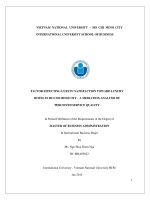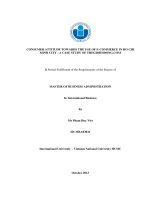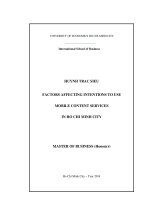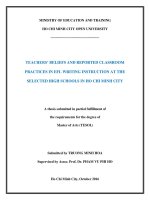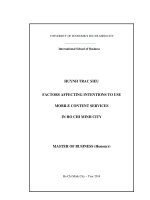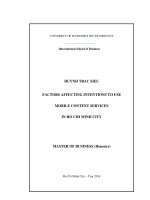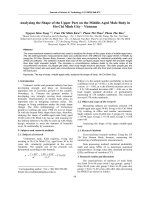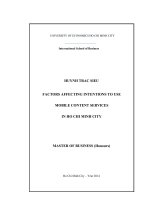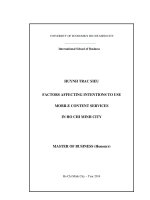Consumer attitude toward the use of e commerce in ho chi minh city a case study of thegioididong com
Bạn đang xem bản rút gọn của tài liệu. Xem và tải ngay bản đầy đủ của tài liệu tại đây (1.01 MB, 58 trang )
CONSUMER ATTITUDE TOWARDS THE USE OF E-COMMERCE IN HO CHI
MINH CITY : A CASE STUDY OF THEGIOIDIDONG.COM
In Partial Fulfillment of the Requirements of the Degree of
MASTER OF BUSINESS ADMINISTRATION
In International Business
By
Mr Pham Huy Viet
ID: MBA03041
International University – Vietnam National University HCMC
October 2013
CONSUMER ATTITUDE TOWARDS THE USE OF E-COMMERCE IN HO CHI
MINH CITY: A CASE STUDY OF THEGIOIDIDONG.COM
In Partial Fulfillment of the Requirements of the Degree of
MASTER OF BUSINESS ADMINISTRATION
In International Business
by
Mr Pham Huy Viet
ID: MBA03041
International University - Vietnam National University HCMC
October 2013
Under the guidance and approval of the committee, and approved by all its members, this
thesis has been accepted in partial fulfillment of the requirements for the degree.
Approved:
---------------------------------------------Chairperson
---------------------------------------------Committee member
---------------------------------------------Committee member
--------------------------------------------Advisor
--------------------------------------------Committee member
--------------------------------------------Committee member
Acknowledge
I would like to express my very great appreciation to my advisor – Dr Ho Nhut
Quang with all my respect and gratitude. Thanks for all his great support to provide
guidelines, challenges ideas, and all of his value comment to help me finish this thesis.
I would like to thank all my friends, my brother and sister to support their ideas,
answer my questions during the time I do this research
And finally I want to say my great thank to my family, who always besides me to
overcome all difficulties during this time.
With many thanks,
Plagiarism Statements
I would like to declare that, apart from the acknowledged references, this thesis
either does not use language, ideas, or other original material from anyone; or has not been
previously submitted to any other educational and research programs or institutions. I fully
understand that any writings in this thesis contradicted to the above statement will
automatically lead to the rejection from the MBA program at the International University –
Vietnam National University Hochiminh City.
Copyright Statement
This copy of the thesis has been supplied on condition that anyone who consults it
is understood to recognize that its copyright rests with its author and that no quotation from
the thesis and no information derived from it may be published without the author’s prior
consent.
© Pham Huy Viet/ MBA03041/ 2013
Table of contents
CHAPTER ONE: INTRODUCTION ................................................................................ 1
1.
Introduction ................................................................................................................. 1
1.1.
Overview of E-commerce.................................................................................... 1
1.2.
Development of e-commerce in Vietnam............................................................ 2
1.3.
Reasons for the Underdevelopment of E-commerce in Vietnam ........................ 2
1.4.
E-commerce models in Vietnam ......................................................................... 2
1.5.
Overview about thegioididong.com .................................................................... 4
2.
Research problem: ...................................................................................................... 7
3.
Research questions:..................................................................................................... 8
4.
Research objectives: ................................................................................................... 8
5.
Scope and limitation ................................................................................................... 9
6.
Implication: ................................................................................................................. 9
7.
Research structure: ...................................................................................................... 9
CHAPTER TWO: LITERATURE REVIEW ................................................................. 10
1.
Consumer attitude: .................................................................................................... 10
2.
Technology acceptance model- TAM: ..................................................................... 10
3.
Research model and hypothesis: ............................................................................... 12
CHAPTER THREE: RESEARCH METHODOLOGY ................................................ 14
1.
Research approach: quantitative ............................................................................... 14
2.
Research process: ...................................................................................................... 14
3.
Questionnaire design................................................................................................. 15
4.
Sampling design ........................................................................................................ 15
5.
Piloting test ............................................................................................................... 16
6.
Data analysis ............................................................................................................. 16
CHAPTER FOUR: DATA ANALYSIS AND RESEARCH RESULT ......................... 19
1.
Sample demographic................................................................................................. 19
2.
Descriptive statistics ................................................................................................. 21
2.1.
Perceived benefit ............................................................................................... 21
2.2.
Perceived ease of use. ........................................................................................ 22
3.
4.
2.3.
Perceived quality of service............................................................................... 23
2.4.
Consumer attitude to online transaction. ........................................................... 24
Reliability test ........................................................................................................... 24
3.1.
Reliability statistic of perceived benefit ............................................................ 24
3.2.
Reliability statistic of perceived ease of use ...................................................... 25
3.3.
Reliability statistic of perceived quality of service ........................................... 26
3.4.
Reliability statistics of consumer attitude to online transaction ........................ 27
Exploratory Factor Analysis ..................................................................................... 27
4.1.
Exploratory factor analysis for independent variables ...................................... 27
4.2.
Exploratory Factor Analysis of Dependent Variable ........................................ 31
5.
Cronbach’s Alpha after exploratory factor analysis ................................................. 32
6.
Regression analysis ................................................................................................... 33
7.
Revision of hypotheses and research model ............................................................. 36
CHAPTER FIVE: CONCLUSION AND RECOMMENDATIONS ............................ 37
1.
Conclusion ................................................................................................................ 37
2.
Recommendations ..................................................................................................... 38
3.
Limitations ................................................................................................................ 39
List of Tables
Table 1: Relationship between perceived value and consumer attitudes to online
transaction ............................................................................................................................ 13
Table 2: coding data summary ............................................................................................. 17
Table 3: Descriptive statistics of perceived benefit ............................................................. 22
Table 4: Descriptive statistics of perceived ease of use....................................................... 22
Table 5: Descriptive statistics of perceived quality of service ............................................ 23
Table 6: Descriptive statistics of consumer attitude ............................................................ 24
Table 7: Reliability statistics of perceived benefit............................................................... 25
Table 8: Reliability statistics of perceived ease of use ........................................................ 25
Table 9: Reliability statistic of perceived quality of service ............................................... 26
Table 10: Reliability statistics of consumer attitude ............................................................ 27
Table 11: Exploratory factor analysis for independent variables ........................................ 28
Table 12: Rotated Component matrix .................................................................................. 30
Table 13: Exploratory factor analysis of dependent variable .............................................. 31
Table 14: Cronbach’s Alpha after exploratory factor analysis ............................................ 32
Table 15: regression analysis ............................................................................................... 33
Table 16: anova test ............................................................................................................. 34
Table 17: coefficient ............................................................................................................ 34
List of Figures
Figure 1: The best e-commerce website in 2012 ................................................................... 4
Figure 2: Thegioididong.com offline store ............................................................................ 6
Figure 3: thegioididong.com online store .............................................................................. 6
Figure 4: Technology Acceptance Model-TAM ................................................................. 11
Figure 5: Research model .................................................................................................... 12
Figure 6: Research Process. ................................................................................................. 14
Figure 7: percentage gender of respondents ........................................................................ 19
Figure 8: percentage of age’s respondents ........................................................................... 20
Figure 9: percentage of marital status .................................................................................. 20
Figure 10: Income description ............................................................................................. 21
Figure 11: Revised Research model .................................................................................... 36
Abstract
As an inevitable trend of the globalization process, E-commerce has become an
indispensable part of today’s modern economy due to its benefits brought to consumers
and businesses, including lower transaction costs, greater convenience and the power of
personalization. Despite the wide adoption of this technology in some developed countries,
many emerging markets are still in the initial stage of implementing the Internet for their
commercial activities.
This research aims to investigate the consumer attitudes to E-commerce and its
adoption in Vietnam. In particular, thegioididong.com website will be studied to identify
the extent of E-commerce usage and the factors that influence. Finally, recommendations
will be provided to address the problems
Key words: e-commerce, consumer, attitude.
CHAPTER ONE: INTRODUCTION
1. Introduction
1.1. Overview of E-commerce
Since the early 1990s, the Internet has brought special change to every aspect in our
society. The Internet has created new industry structures and transformed the rules of
competition in the marketplace, changing such things as intensity of rivalry, threats of new
entrants, bargaining power of suppliers and buyers, and threats of substitutes (Stegwee,
2001) (Porter, 2001). The market therefore demands an entirely new business culture and
set of processes for organization to better adapt to the advanced technology (Means,
Faulkner, 2000).With the development of internet, it also introduced new business model:
e-commerce.
Electronic commerce, commonly known as e-commerce, is the buying and selling
product or service over electronic systems such as the Internet and other computer
networks. Electronic commerce draws on such technologies as mobile commerce,
electronic funds transfer, supply chain management, Internet marketing, online transaction
processing, electronic data interchange (EDI), inventory management systems, and
automated data collection systems. Modern electronic commerce typically uses the World
Wide Web at least at one point in the transaction's life-cycle, although it may encompass a
wider range of technologies such as e-mail, mobile devices social media, and telephones as
well. Electronic commerce is generally considered to be the sales aspect of e-business. It
also consists of the exchange of data to facilitate the financing and payment aspects of
business transactions.
E-commerce has become a source for organizational competitive advantage for
today’s marketplace participants (Peffers, Santos, 1998). E-commerce is used as a new
innovation strategy within many business sectors in order to increase business
competitiveness. According to Watson et al. (1998), E-commerce involves the use of
information technology to enhance communications and transactions with all of an
organization’s stakeholders such as customers, suppliers, government regulators,
managers, employees,... E-commerce has changed and is still changing the way business is
conducted around the world.
1
1.2. Development of e-commerce in Vietnam
E-commerce is in the initial stage in Vietnam. The local companies are improving
their awareness of importance and effectiveness of the application of information
technology and e-commerce to their business. Most companies have established their own
websites to introduce products and services to customers and clients as well as to
implement online sale and purchase (B2C) or built up websites to gather many companies
to introduce products and services (B2B). A large number of e-commerce websites have
made their successful online presence in Vietnam including vatgia,thegioididong.com etc.
Owners of these websites can be trade offices, governmental agencies, or even companies
or individuals. In addition, the increasing development of middle class has given ecommerce good opportunities to flourish. It is easier than ever for online consumers to
compare products from different vendors with respect to prices, quality and promotion.
Together with the phenomenal growth of social networking sites, E-commerce has
increasingly proven to be a very effective trading channel strongly competing with brickand-mortar retail shops.
1.3. Reasons for the Underdevelopment of E-commerce in Vietnam
Due to slow development of IT infrastructure as well as of policies, legal
environment, intellectual property protection, privacy rights, etc, Vietnamese enterprises
and consumers have not been eager and confident enough to participate in e-commerce. In
addition, there has been reported a considerable number of fraud incidents such as
muaban24.com and nhommua.com that create negative sentiments in the market.
Moreover, Vietnamese enterprises lack of appropriate business models and processes
which can greatly benefit from E-commerce. This requires significant changes in how
businesses should be conducted and supports from government
1.4. E-commerce models in Vietnam
E-commerce is classified according to the transaction. There are two main types:
B2B (business-to business) and B2C (business-to-consumer).Business-to-business (B2B)
describes commerce transactions between businesses, such as between a manufacturer and
a wholesaler, or between a wholesaler and a retailer. An example of electronic B2B is a
clothing designer linking up electronically to a fabric supplier whereby the designer
2
specifies his/her fabric needs, pays for the order, and then the supplier initiates the
fulfillment of that order by computer. B2B technologies like that of E-Gov and B2C
usually take some time to develop as they are fairly complex and require a certain mastery
of the technology used.
Vietnam's B2B solutions at the moment are few and far between. Much like the
other B2C and e-gov websites mentioned, Vietnamese B2B sites tend to be more
informational
than
interactive.
For
example,
the
sites
MekongSources.Com,
VietVentures.Com, and VietnamE-Commerce.Com attempt to link Vietnamese businesses
with foreign businesses while also giving viewers an overall sense of the business/legal
environments in Vietnam. Where the sites succeed is in their presentation of information.
Where they fail however is in their attempt to link Vietnamese companies with foreign
companies, mainly by way of search engines and the presentation of contact information.
A number of other websites including MeetVietnam.com, which heralded infinite hype in
early 2001 as a government sponsored website to promote B2B activities, have not
materialized as well.
Business-to-consumer (B2C) describes commerce transactions between a company
and a consumer. This term may also describe a company that provides good and services
for consumers.B2C is prevalent in developed countries that have established means for
completing electronic transactions (i.e. a developed mail system, electronic forms of
payment, etc.) As such many lesser developed countries tend not to utilize B2C
technologies because their infrastructures are unable to support the technology. An
example of B2C is Amazon.com, a world-wide Internet retailer of books and other goods.
To showcase two B2C websites that defy the conventions set forth above and that
do work (though inconsistently), see Huong Viet Flowers, which allows users to have
flowers delivered 24 hours a day to Vietnamese citizens from anywhere in the world, and
VietnamHost.Com, which through its network allows users to transfer cash in order to
complete online transactions. For example about B2C model, Minhkhai book store,
Fahasa, thegioididong.com,…
3
Beside these two models, E-commerce also have many new models such as
C2C(consumer-to-consumer), C2B (consumer-to-business), G2C (government-to-citizens),
and online banking
1.5. Overview about thegioididong.com
In the socioeconomic development, internet becomes more common to everyone,
especially in finding product’s information, to compare and evaluate before purchase.
Thegioididong.com first went online in 2003 and is a complementary online store to
Thegioididong.com physical store network, which includes 226 outlets as of april 30th,
2012. Since established, Thegioididong.com has become the leading mobile device retailer
in Vietnam with approximately 20% market share. Thegioididong.com is the best website
in Vietnam on the mobile, laptop and others digital equipments ( camera, Mp3, Mp4…),
with more than 600.000 page views/ day in mobile webpage.
The number of visitors of www.thegioididong.com increase every day,
www.thegioididong.com usually attach to special importance to update both its content and
interface, accompany with online and offline advertising campaign creatively. Visitors
have an average age of 15-35 years old.
Figure 1: The best e-commerce website in 2012
From the business perspective, thegioididong.com business model is B2C. It earns
revenue through sales and leasing advertising space on its website. Remarkably,
4
thegioididong.com also serves as the top online manual for mobile devices, enabling quick
and easy discovery of product information. In 2003, mobile phone was still a luxury good
to Vietnamese people. If one decided to purchase a mobile phone, he would be skeptical
about which product to choose. However, at that time, Vietnamese mobile phone industry
was very lack of information concerning models, features, prices, etc. Thegioididong.com
came forth as the very first website to make all this information available specifically to
Vietnamese customers and integrate them all into one place. The website has helped to
reduce greatly the time and effort people spend on searching information and comparing
products to arrive at the best purchasing decisions.
Such information transparency has increased the competitiveness in this industry,
leading to lower prices and better customer services, which greatly benefits customers.
Retailers are forced to operate in a more cost-efficient and customer-oriented manner to
remain competitive. Some major direct competitors of Thegioididong.com include Vien
Thong A, Phuoc Lap Mobile, Viettel and FPT. Together
they account for 40% of
Vietnam’s mobile phone retail market. Facing increasing competition, Thegioididong.com
still remains the biggest player in its niche due to superior customer exposure, strategic
customer relationship management and visionary leadership. Despite the success of
Thegioididong.com as a whole, online sales remain low. In 2011, Thegioididong.com
online sales account for only 9% of the total revenue. According to IDC Vietnam,
Vietnamese customers prefer to go to physical stores to see, touch and check the product
themselves. They also favor cash payment over other modes of exchange. These are the
primary factors that hinder online sales success.
Some awards of thegioididong.com :
- Best E-commerce Website Award 2008 by PC World Magazine
- Best Mobile Phone Retail Chain for 2007 by eChip magazine
- Vietnam the best 2007 by Vietnam Network
- Fastest growth dealer of FPT Mobile
- Fastest growth dealer of FPT Mobile ( NOKIA)
5
Figure 2: Thegioididong.com offline store
Figure 3: thegioididong.com online store
6
2. Research problem:
E-commerce brings many good effects to economic, it opens many new ways for
economic such as create many new jobs, reduce many unnecessary costs, stimulate
competition, social stimulus and stimulate product development that satisfy the consumer
demands. It made business more dynamic in management and more creative business
ideas.
-
With business:
o It help to widen the market not only domestic but also foreign. With the
minimum cost, business can get more customers, find the best suppliers,
and suitable partners all over the world.
o It reduced management cost, save information, telecommunication,
postal, inventory and delivery.
o Shorten response time to customers: online purchasing order will be
handle quickly by salesperson with computerized tools and goods will
be deliver as soon as possible to customers.
o Shorten time to introduce product to the current market, with online
customer network, business can get many comments of customers. With
working online, all parts of a company can share information together to
complete products for market.
o Create many type of business model bring many benefits.
o Business management is better base on computerization.
o Pay more attention to customer service base on informatics tools with
all data about customer.
-
With customer:
o Customer feels comfortable about time and space: they can purchase
good wherever and whenever they want.
o Customer have more option when purchasing because of many
suppliers, many reference information. On internet, customer can find
many good suppliers easily and quickly
o Better price because the suppliers can reduce production and
management cost.
7
o With some special good that can be digitized like books, newspaper,
film, music, software, … time for delivery can be shorten.
o Customer can share experience together on website or forum.
-
With society:
o Make many jobs, opportunities for society: when e-commerce develops,
computer industry, telecommunications, software industry, forwarder
industry, also develop better. Many new jobs will appear with service
for e-commerce for all above industries.
o Reduces many cost for society such as: management, production,
transportation..
o Improve quality of many services: more information, faster, more
accurate …
Despite the above competitive advantages that E-commerce has brought to
enterprises and consumers, and the effect of thegioididong.com to Vietnam market and
transaction online, there have been rising concerns about security, lack of infrastructure
and legal complications, especially in developing countries like Vietnam. As the result, the
use of E-commerce in Vietnamese businesses is not as high as other developed nations.
That is the reason make the consumer do not believe and use e-commerce as the developed
country in the world. This research will consider e-commerce in the case of
thegioididong.com to develop a new way for changing consumer attitudes to e-commerce
adoption.
3. Research questions:
What are the important factors that influence consumer attitude towards the use
of Thegioididong.com website?
What are the challenges that Thegioididong.com are facing with and how to
solve these problems?
4. Research objectives:
This research aims to solve the problem of underdevelopment of E-commerce in
Ho Chi Minh city, use the case of thegioididong.com. The detailed objectives are as
followed:
8
-
Define and evaluate the factors that effect to consumer attitude of using
e-commerce, especially in trading in thegioididong.com
-
Suggest a policy implication for strategy to improve quality of
thegioididong.com
5. Scope and limitation
-
Research objects are e-commerce websites, especially the case of
Thegioididong.com. This research will be carried in Ho Chi Minh city,
that the most attracted market for transaction online.
6. Implication:
This study aimes to provide a comprehensive understand about e-commerce and
trading online. From the data analyzed, managers of e-commerce website will understand
clearly about the negative and positive impacts of e-commerce to consumers. This research
hopes to find the factors that effected to e-commerce adoption and makes it useful and
suitable to the business environment in Ho Chi Minh city.
7. Research structure:
The structure of the thesis consist five chapters:
Chapter 1: Introduction this chapter presents research background of the thesis,
as well as, research questions, research objectives, research methodology and
scope.
Chapter 2: Literature review this chapter address the theory of consumer attitude,
factors that affect consumer attitude, Technology acceptance model in order to give
a clear ideas about the research area.
Chapter 3: Research methodology this chapter presents the design, approach,
questionnaire of my thesis.
Chapter 4: Data analysis and research results this chapter analyzes the data
collect and presents the finding of research.
Chapter 5: Conclusions and Recommendations this chapter focuses on
discussing the final results of the study and suggestions for improvement.
9
CHAPTER TWO: LITERATURE REVIEW
Important theoretical models and frameworks related to E-Commerce will be
presented in this section.
1. Consumer attitude:
Consumer attitudes are a composite of a consumer’s beliefs about, feelings
about, and behavioral intentions toward some object--within the context of
marketing, usually a brand or retail store (Perner). These components are
viewed together since they are highly interdependent and together represent
forces that influence how the consumer will react to the object.
Beliefs. The first component is beliefs. A consumer may hold both positive
beliefs toward an object as well as negative beliefs. In addition, some beliefs
may be neutral, and some may be differ in valance depending on the person or
the situation. Note also that the beliefs that consumers hold need not be
accurate, and some beliefs may, upon closer examination, be contradictory.
Affect. Consumers also hold certain feelings toward brands or other
objects. Sometimes these feelings are based on the beliefs, but there may also be
feelings which are relatively independent of beliefs.
Behavioral Intention. The behavioral intention is what the consumer plans
to do with respect to the object (e.g., buy or not buy the brand). As with affect,
this is sometimes a logical consequence of beliefs (or affect), but may sometimes
reflect other circumstances--e.g., although a consumer does not really like a
restaurant, he or she will go there because it is a hangout for his or her friends.
2. Technology acceptance model- TAM:
Technology Acceptance Model was developed by Davis(1986) base on
Theory of Reasoned Action –TRA of Fishbein and Ajzen(1975). TAM is basically
information system theory that covers how a user accepts and uses technology,
TAM outlines number of factor that influence a user’s decision and at the same
time it deals with the how and when users will use it. The model deals with
acceptance of information technology.
10
This model had five main variables that influence users to make a decision
are.
-
External variable: this was the variables that effect directly to Perceive
usefulness and Perceive ease of use.
-
Perceived usefulness: people recognized that using the system of
separate applications will develop work effectiveness to a job.
-
Perceived ease of use: was the easy way when people used this system.
-
Attitude towards using: was the attitude of using a system that created
by belief in usefulness and ease of use.
-
Behavioral intention of use: was the intention of people to using this
system.
According to Davis, PU was the main point and PEU was the second main
point affect to using computer of people. TAM agreed two factors PU and
PEU that were the basic decisions to system acceptance of people
Figure 4: Technology Acceptance Model-TAM
This model was the result of economic foreign researcher about information
technology application, they mentioned about search information, purchasing of
customer on Internet. However, this model just was the studies of foreign customer,
so they will have some differences from business environment in Vietnam,
especially in Ho Chi Minh city.
When apply this two model in Vietnam to start business transactions, on
internet and special in e-commerce with the case of thegioididong.com, what factor
affect to e-commerce adoption we should mentioned to success ?
11
The above model recommended to attitudes and behaviors of consumer, but
in this study, I only recommended to consumer attitudes because if someone had a
good attitude about product/service, it will lead them to a good behavior.
3. Research model and hypothesis:
Perceived benefit
H1
H2
Perceived ease of use
H3
Consumer attitude to online
transaction
Perceived quality of service
Figure 5: Research model
Figure 7 illustrates the influence of three factors to consumer attitudes to trading online
base on Technology Acceptance Model(TAM)
12
Hypothesis
From the Research model in Figure 6, a number of hypotheses were generated as
table 1 indicated the relationship between perceived benefit, perceived ease of use,
perceived quality of service with consumer attitudes to online transaction.
Table 1: Relationship between perceived value and consumer attitudes to online
transaction
H1
Perceived benefit influences to consumer attitude to online transaction
H2
Perceived ease of use influences to consumer attitude to online transaction
H3
Perceived quality of service influences to consumer attitude to online transaction
13
CHAPTER THREE: RESEARCH METHODOLOGY
1. Research approach: quantitative
In this thesis, both of two methods qualitative and quantitative were also used by
researcher, but quantitative approach is the main point. The quantitative method is done by
surveying the questionnaires with the sample size 205.
This primary reason for conducting quantitative research was to learn how many
people in a population satisfied about thegioididong e-commerce website. Quantitative
research was appropriated for measuring the perceived of consumer attitude about the use
of e-commerce. Base on that, thegioididong.com will have the solution to improve their
service to satisfy the consumer as well as to get more market.
2. Research process:
Literature
review
Reliability test
Research
model
Collecting data
EFA
Analysis of
Variance
Hypothesis
Questionnaire
Design
Pilot test
Draft
Measurement
Discussion and
Conclusion
Figure 6: Research Process.
Research process began with literature review, then came up with research model
and hypotheses. Next, pilot test helped to get feedbacks from respondents and test the
reliability of the scale before completing measurement and questionnaire for collecting
data. In analysis stage, reliability test, EFA, ANOVA were used. Finally, base on the result
of the test, conclusion and recommendation were given.
14
3. Questionnaire design
Base on the result of the in-depth interview, the questionnaire is designed in order
to get data from consumers. To avoid the respondents ‘confusedness, all the statements that
given in the questionnaire are simple and easy to understand.
There are two parts in the questionnaire. The first part mentions some demographic
question about consumer’s information. And the second part includes questions consumer
attitudes and perceived quality.
The questionnaire will be distributed and return by two way: by google doc and
direct contact to participants.
Three types of questions used can be named as list questions, category question,
and Grid questions. Grid questions are designed as the form of five-point Likert Scale
matrix. Researcher used five-point Likert scale matrix in order to get respondent’s idea
clearly from “totally disagree “(=1) to “totally agree”(=5).
4. Sampling design
“ A population was a group of potential participants to whom you want to
generalize the results of a study” (Salkind, 2006). In order to conduct a survey, the
population should be defined. But in some cases, we cannot access all the units of the
population because it can waste a lot of time. In this case, sample was a good solution,
sample was defined as a small percentage of a population.
In this research, the population was defined that all consumers who lives in Ho Chi
Minh city and Binh Duong.
Frame sample: choosing one part of population to observation, accomplish survey
with 205 consumers who used e-commerce.
The sample size for this finding can be five times compared with number of
variables analyzed as recommend sample size by Hair et al. (1998). The model research
has 19 variables, sample size is 19 multiply 5 equal 95 (n= 19*5). To meet sample size,
author sent 300 questionnaire survey copies.
15
